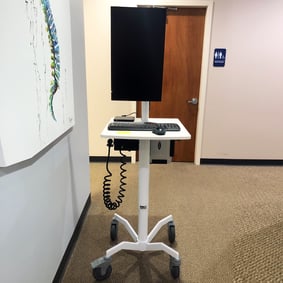By First Products on 7/26/21 2:28 PM
As technology revolutionizes the operation of Healthcare facilities, the physical design of Healthcare spaces changes to meet modern standards.
The mobile medical carts and workstations on wheels are changing how hospitals, clinics, and medical offices function, their role in healthcare environment design is becoming more apparent.
The Reaction to COVID-19
The global pandemic will continue to influence the way healthcare facilities operate well beyond the current crises. The need for improved infection control is just one aspect that could inspire a range of new design choices, from the addition of atriums where staff can safely remove PPE to redesigned waiting rooms that reduce patients’ risk of exposure.
To reduce transmission, some healthcare providers are even rethinking the design of shared workstations. Medical carts and mobile workstations prevent crowding by reducing the need for all staff to share a single, permanent station.
Integrating New Technologies
In the future, healthcare environments will need to adapt to a range of new technologies, including the integration of robotics and artificial intelligence at medical facilities and the growing demand for telemedicine services.
Medical carts and workstations have already facilitated the increased use of telemedicine during the pandemic. Their ability to integrate and power a range of clinical devices and technologies will be a vital component of this ongoing transformation.
Flexibility and Adaptation
As the pandemic has proven, healthcare environments must be flexible and able to adapt to rapidly changing conditions. Mobile carts and workstations make it easier for clinics and medical facilities to alter their spaces to fit evolving needs.
For instance, almost any space can become an appropriate venue for telehealth services simply by integrating a mobile medical cart with wireless and video-conferencing technologies.
A Patient-Centered Approach to Healthcare Design
Healthcare environment design has long centered on critical functions: Waiting rooms were configured to seat many people for short periods, while hospital rooms and exam rooms were configured to function as little else. But while critical function still rules design, providers are beginning to focus more attention on the needs of patients and their families.
This means building more comfortable spaces for both, including an emphasis on private hospital rooms. Mobile medical carts and workstations will play a significant role in the transformation to more patient-centered designs, given their ability to bring a range of diagnostic and monitoring equipment directly into hospital rooms and exam rooms.
Planning for the Consequences of Climate Change
From spikes in emergency care after natural disasters to an increase in medical issues associated with poor air quality or inadequate food supply, healthcare providers could soon be dealing with the consequences of climate change.
Battery-powered mobile medical carts and workstations facilitate quick adaptation in the face of changing circumstances. They will likely prove crucial as hospitals and clinics struggle to provide uninterrupted services during weather-related emergencies or anytime admissions surge.
Accommodating the Shift to Virtual Care
As more and more American consumers become accustomed to online services, their desire to schedule doctor’s appointments, order medication refills, and communicate with caregivers from the comfort of home is only going to intensify. The growing focus on access and convenience will require designers to rethink long-held assumptions about spaces dedicated to waiting, admitting, and registration. The need to accommodate mobile medical carts and workstations will increase as more and more space is devoted to telehealth and telemedicine services.
Prioritizing Health and Wellness of Medical Professionals
Todays’ healthcare professionals face incredible stresses on the job, both mentally and physically. In response to this crisis, healthcare environment designers are beginning to incorporate respite areas where caregivers can decompress from the stress of their work.
Designers are also looking for ways to create spaces that will enable staff to perform their work more efficiently and effectively. To ensure these spaces deliver the desired benefits, providers will require ergonomically friendly carts and workstations configured to reduce the stress and strain mobile medical devices might otherwise impose on staff.
First Products: Helping Providers Design More Flexible Environments
Medical equipment that supports a flexible, patient-centered environment is more essential than ever.
From our Mov-It line of configurable telemedicine carts and tablet roll stands to EMR/EHR charting technology, First Products offers a range of innovative, high-quality, and ergonomically superior solutions specifically designed to meet the ever-changing requirements of today’s medical facilities and clinicians.
 We’ve been helping healthcare providers develop perfect-fit solutions for over 50 years. To learn more and arrange for your complimentary demo, please contact First Products today at 800.854.8304.
We’ve been helping healthcare providers develop perfect-fit solutions for over 50 years. To learn more and arrange for your complimentary demo, please contact First Products today at 800.854.8304.
_11wX8.5h-FINAL.png?width=721&name=FP-Logo-Horizontal-(COLOR)_11wX8.5h-FINAL.png)
.jpg)


comments